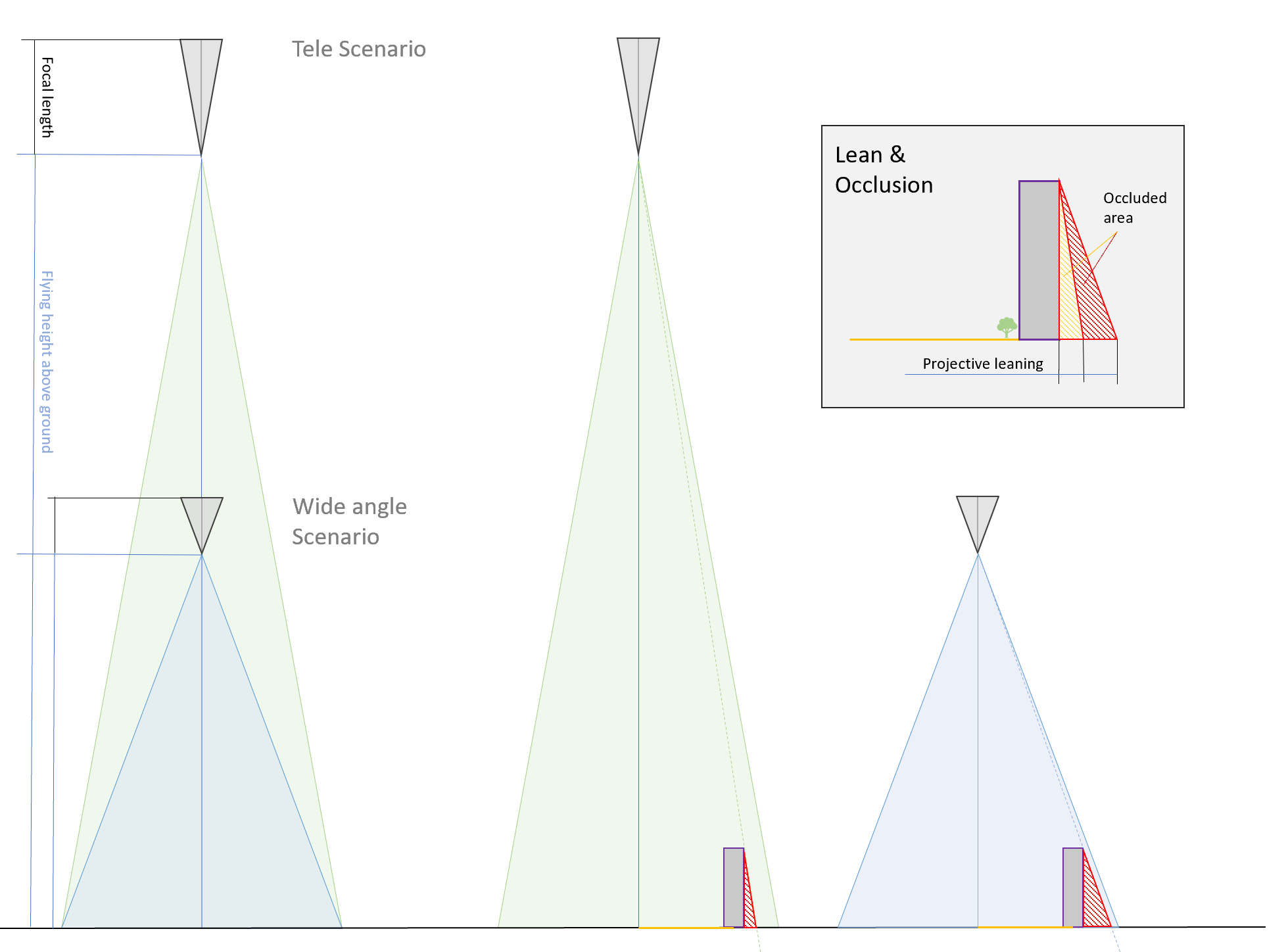Output Quality & Focal Length
The output quality of SURE products is depending on the input data and its quality.
The impact and parameters can be classified according to two major applications:
Ortho Production – targeting at clean Ortho and True Ortho imagery
3D Production – using stereo to target 3D information like DSMs, Meshes, and Point Clouds
The specific needs for each of the applications require a conscious selection of the camera setup and acquisition parameters to reach the desired output quality while being cost-efficient.
Ortho Productions work ideal if the input imagery already provides a close to orthographic view of each point on the ground. This can be achieved through long focal lengths (e. g. efficient high altitude content programs), which generally reduces building lean effects or through providing highly overlapping stereo imagery. The following schematic drawing shows two different camera setups (green - tele; blue: wide-angle). A shorter focal length (wide-angle) introduces more occlusions and lean compared to a tele setup.
3D Productions use the principles of stereo Photogrammetry. Therefore, each pixel requires multiple views forming stereo models with a baseline. An intersection angle (baseline) is required to achieve depth information at high quality. Image similarity is at the same time needed to perform image matching. The following schematic drawing shows the same camera setup as above. On the one hand, a longer focal length (tele) enables to fly at higher altitude to achieve the same GSD, which makes the base-to-height-ratio less favorable (smaller intersection angle) and introduces a larger depth error. On the other hand, image similarity is better represented by tele setups and less optimal for wide-angle setups.
Considering both image similarity and intersection angle as illustrated in above schematic drawing, a setup between tele and wide-angle is most optimal for 3D Productions, the so-called balanced setup. An assessment about the impact of each mentioned setup on various quality factors is also given in below table. Beforehand, quality characteristics and quality factors are being introduced. Furthermore, concrete recommendations are presented.
Quality characteristics
A qualitative result is achieved if the following requirements are met:
Accurate: features are located correctly
Sharp: sharp details and edges
Clean: free of artifacts
Complete: no gaps or interpolation artifacts
Quality factors
The impact on output quality can be categorized as follows:
Resolution (GSD)
Stereo capability (base-to-height ratio or intersection angle)
Occlusions (pixels that do not have enough stereo models)
Atmospheric impact on radiometry (haze)
The selection of focal lengths according to the target GSD – or vice versa the selection of an operation GSD range for a given focal length, is key for good output quality for both Ortho and 3D.
For an identical ground resolution (e. g. 5cm GSD) and image overlap (e. g. 80/60) of a traditional 5-head camera system (e. g. considering a standard opening angle in Nadir and with 45° oblique), the impact of focal lengths can be approximately as follows:
Scenario | Focal length | Typical opening angles | Stereo | Occlusions | Occlusions Oblique | Atmospheric impact on radiometry |
|---|---|---|---|---|---|---|
Wide angle | Short | 80° … 100° | optimal | strong | reduced | reduced |
Balanced | Normal | 45° … 65° | optimal | average | average | average |
Tele | Long | < 35° | non-optimal | reduced | very strong | very strong |
The table illustrates that the focal length has an impact on output quality. Ortho collection also works excellently at high altitudes even with limited stereo capability. If 3D output products (e.g. Mesh, DSM) are required, the stereo capability needs to be considered beside the amount of occlusion in order to achieve a sharp and clean result.
As quality decreases for long focal lengths due to glancing intersections (poor base-to-height ratio), a higher resolution GSD might be needed to achieve the same level of quality as on a balanced setup. To avoid data occlusions, completeness needs to be ensured – especially on the lower part of building facades.
Recommendations
For pure Ortho projects, where no 3D information is required, we recommend using balanced or Tele setups for optimum productivity. Please note that qualitative differences can result from the atmospheric haze.
As soon as 3D products are targeted, we recommend using a balanced system with normal opening angles providing good stereo at the operating GSD range to achieve optimal output quality for both Ortho and 3D products.
If flight restrictions require operating long focal lengths, the ground resolution should be chosen towards higher resolution to compensate for losses in stereo precision (base-to-height ratio), stronger oblique occlusions and to reduce further radiometric loss through the haze. For cities, we recommend 5 cm GSD or better in such a scenario to achieve a visually pleasing result.
If flight restrictions require operating short focal lengths, we recommend operating at higher overlap (e.g. 80/80) to compensate for occlusions in the Nadir frame resulting from perspective distortion. Flying at low altitudes provides the opportunity of flying under overcast conditions (below clouds), which is ideal for Photogrammetry (homogenous color, no loss in shadows).

